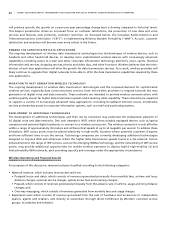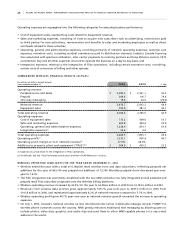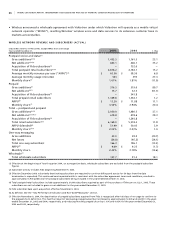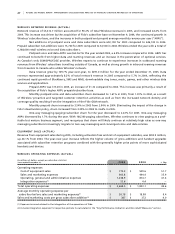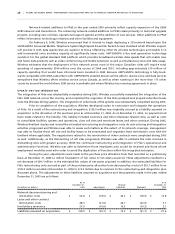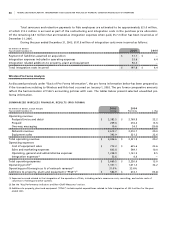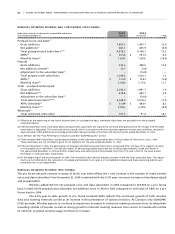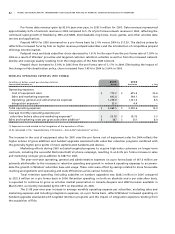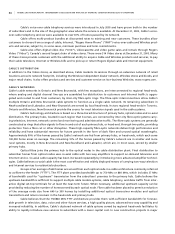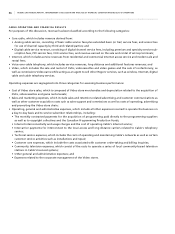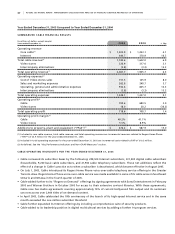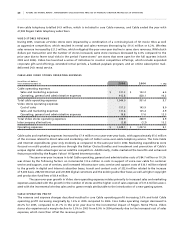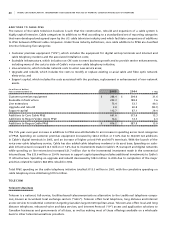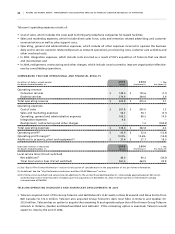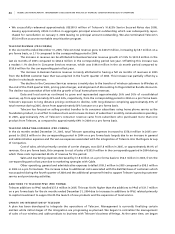Rogers 2005 Annual Report Download - page 38
Download and view the complete annual report
Please find page 38 of the 2005 Rogers annual report below. You can navigate through the pages in the report by either clicking on the pages listed below, or by using the keyword search tool below to find specific information within the annual report.
34 ROGERS 2005 ANNUAL REPORT . MANAGEMENT’S DISCUSSION AND ANALYSIS OF FINANCIAL CONDITION AND RESULTS OF OPERATIONS
Cable’s voice-over-cable telephony services were introduced in July 2005 and have grown both in the number
of subscribers and in the size of the geographic area where the service is available. At December 31, 2005, Cable’s voice-
over-cable telephony services were available to over 81% of homes passed by its network.
Cable offers multi-product bundles at discounted rates to existing and new customers. These bundles allow
customers to choose from a range of cable, Internet, “Rogers Home Phone” (“RHP”) voice-over-cable and Wireless prod-
ucts and services, subject to, in some cases, minimum purchase and term commitments.
Cable also offers digital video disc (“DVD”), videocassette and video game sales and rentals through Rogers
Video (“Video”), Canada’s second largest chain of video stores. There were 314 Video stores at December 31, 2005. Many
of these stores provide customers with the additional ability to acquire Cable and Wireless products and services, to pay
their cable television, Internet or Wireless bills and to pick up or return Rogers digital cable and Internet equipment.
CA B L E’ S D I ST R I BU T IO N
In addition to the Video stores, as described above, Cable markets its services through an extensive network of retail
locations across its network footprint, including the Wireless independent dealer network, Wireless stores and kiosks, and
major retail chains. It also offers products and services and customer service on its e-business Web site, www.rogers.com.
CA B L E’ S N E TW O R KS
Cable’s cable networks in Ontario and New Brunswick, with few exceptions, are interconnected to regional head-ends,
where analog and digital channel line-ups are assembled for distribution to customers and Internet traffic is aggre-
gated and routed to and from customers, by inter-city fibre-optic rings. The fibre-optic interconnections allow Cable’s
multiple Ontario and New Brunswick cable systems to function as a single cable network. Its remaining subscribers in
Newfoundland and Labrador, and New Brunswick are served by local head-ends. Its two regional head-ends in Toronto,
Ontario and Moncton, New Brunswick provide the source for most television signals used in the cable systems.
Cable’s technology architecture is based on a three-tiered structure of primary hubs, optical nodes and co-axial
distribution. The primary hubs, located in each region that it serves, are connected by inter-city fibre-optic systems carry-
ing television, Internet, network control and monitoring and administrative traffic. The fibre-optic systems are generally
constructed as rings that allow signals to flow in and out of each primary hub, or head-end, through two paths, providing
protection from a fibre cut or other disruption. These high-capacity fibre-optic networks deliver high performance and
reliability and have substantial reserves for future growth in the form of dark fibre and unused optical wavelengths.
Approximately 90% of the homes passed by Cable’s network are fed from primary hubs, or head-ends, which each serve
100,000 home areas on average. The remaining 10% of the homes passed by Cable’s network are in smaller and more
rural systems, mostly in New Brunswick and Newfoundland and Labrador, which are, in most cases, served by smaller
primary hubs.
Optical fibre joins the primary hub to the optical nodes in the cable distribution plant. Final distribution to
subscriber homes from optical nodes uses co-axial cable with two-way amplifiers to support on-demand television and
Internet service. Co-axial cable capacity has been increased repeatedly by introducing more advanced amplifier technol-
ogies. Cable believes co-axial cable is the most cost-effective and widely deployed means of carrying two-way television
and Internet services to residential subscribers.
Groups of an average of 640 homes are served from each optical node in a cable architecture commonly referred
to as fibre-to-the-feeder (“FTTF”). The FTTF plant provides bandwidth up to 750 MHz or 860 MHz, which includes 37 MHz
of bandwidth used for “upstream” transmission from the subscribers’ premises to the primary hub. Cable believes the
upstream bandwidth is sufficient to support multiple cable modem systems, cable telephony, and data traffic from inter-
active digital set-top terminals for at least the near-term future. When necessary, additional upstream capacity can be
provided by reducing the number of homes served by each optical node. Fibre cable has been placed to permit a reduction
of the average node size from 640 to 300 homes by installing additional optical transceiver modules and optical
transmitters and return receivers in the head-ends and primary hubs.
Cable believes that the 750/860 MHz FTTF architecture provides them with sufficient bandwidth for foresee-
able growth in television, data, voice and other future services, a high quality picture, advanced two-way capability and
increased reliability. In addition, Cable’s clustered network of cable systems served by regional head-ends facilitates its
ability to rapidly introduce new services to subscribers with a lower capital cost. In new construction projects in major


